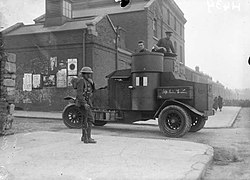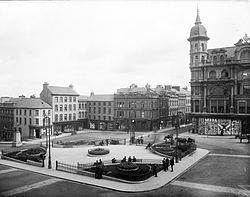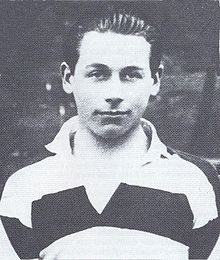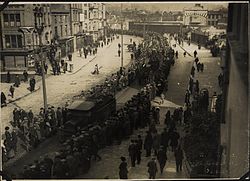
The Irish War of Independence, also known as the Anglo-Irish War, was a guerrilla war fought in Ireland from 1919 to 1921 between the Irish Republican Army and British forces: the British Army, along with the quasi-military Royal Irish Constabulary (RIC) and its paramilitary forces the Auxiliaries and Ulster Special Constabulary (USC). It was part of the Irish revolutionary period.

Bloody Sunday was a day of violence in Dublin on 21 November 1920, during the Irish War of Independence. More than 30 people were killed or fatally wounded.

Mourne Abbey, or Mourneabbey, is a small civil and Roman Catholic parish in the barony of Barretts, northwest County Cork, Ireland. The parish is situated just south of Mallow, on the main Mallow-Cork Road and Rail Line. The population of the parish is about 1,000 people. There are two churches and schools in the area, Analeentha and Burnfort. The civil parish consists of 17 townlands.
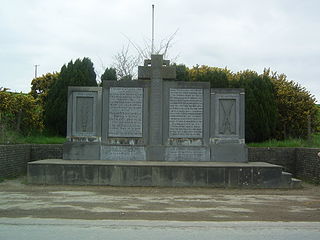
The Crossbarry ambush, also known as the Battle of Crossbarry, occurred on 19 March 1921 and was one of the largest engagements of the Irish War of Independence. It took place near the small village of Crossbarry in County Cork, about 20 km south-west of Cork city. About a hundred Irish Republican Army (IRA) volunteers, commanded by Tom Barry, escaped an attempt by about 1,200 British troops to encircle them. During the hour-long battle, ten British troops and three IRA volunteers were killed.
The Scramoge ambush was an ambush carried out by the Irish Republican Army (IRA) on 23 March 1921, during the Irish War of Independence. The IRA ambushed a lorry carrying British troops and Royal Irish Constabulary (RIC) officers at Scramoge, near Strokestown in County Roscommon. Three British soldiers and an RIC officer were killed, while two RIC 'Black and Tans' were captured and shot dead shortly after.
The Clonfin Ambush was an ambush carried out by the Irish Republican Army (IRA) on 2 February 1921, during the Irish War of Independence. It took place in the townland of Clonfin between Ballinalee and Granard in County Longford. The IRA ambushed two lorries carrying members of the British Auxiliary Division, sparking a lengthy gun battle in which four Auxiliaries were killed and eight wounded. The Auxiliaries eventually surrendered and their weapons were seized. The IRA commander, Seán Mac Eoin, won some praise for helping the wounded Auxiliaries. Following the ambush, British forces burned a number of houses and farms in the area, and shot dead an elderly farmer.
Roger McCorley was an Irish republican activist.
The Selton Hill ambush took place on 11 March 1921, during the Irish War of Independence. An Irish Republican Army (IRA) flying column was ambushed by members of the RIC Auxiliary Division at Selton Hill, County Leitrim. Six IRA members of the South Leitrim Brigade were killed, which effectively destroyed the IRA in South Leitrim.
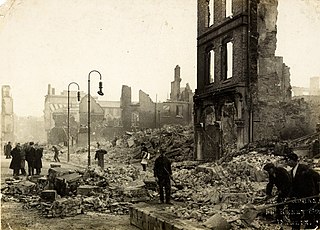
The burning of Cork, by British forces, took place during the Irish War of Independence on the night of 11–12 December 1920. It followed an Irish Republican Army (IRA) ambush of a British Auxiliary patrol in the city, which wounded twelve Auxiliaries, one fatally. In retaliation, the Auxiliaries, Black and Tans and British soldiers burned homes near the ambush site, before looting and burning numerous buildings in the centre of Cork, Ireland's third-biggest city. Many Irish civilians reported being beaten, shot at, and robbed by British forces. Firefighters testified that British forces hindered their attempts to tackle the blazes by intimidation, cutting their hoses and shooting at them. Two unarmed IRA volunteers were also shot dead at their home in the north of the city.

The Headford Ambush was carried out by the Irish Republican Army (IRA) on 21 March 1921, during the Irish War of Independence. The IRA's 2nd Kerry Brigade ambushed a train carrying British troops of the Royal Fusiliers at Headford Junction railway station near Killarney, County Kerry. This sparked a battle lasting almost an hour, in which at least 13 people were killed – nine British soldiers, two IRA volunteers and three civilians. The IRA withdrew after another train carrying British troops arrived.
The Tooreen ambush was an ambush carried out by the Irish Republican Army (IRA) on 22 October 1920, during the Irish War of Independence. It took place near Roberts Farm, Tooreen, near Ballinhassig in County Cork. The IRA ambushed two lorries of British soldiers, killing three and wounding four others. The British surrendered and their weapons and ammunition were seized by the IRA. Later that night, British soldiers went on a rampage in nearby Bandon.
The Clonbanin ambush was an ambush carried out by the Irish Republican Army (IRA) on 5 March 1921, during the Irish War of Independence. It took place in the townland of Clonbanin, County Cork.
The Clonmult ambush took place on 20 February 1921, during the Irish War of Independence.
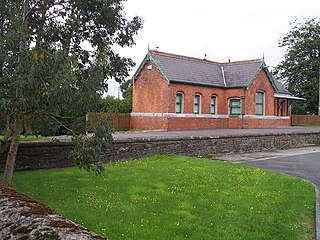
The Upton train ambush took place on 15 February 1921, during the Irish War of Independence. The Irish Republican Army (IRA) mounted an attack on a train carrying British soldiers at Upton, County Cork. The action was a disaster for the IRA; three of its volunteers were killed, two wounded and one captured. Six British soldiers were wounded, three seriously. At least eight civilian passengers were killed and ten wounded in the crossfire.
The Pickardstown ambush, an action in the Irish War of Independence, took place near the town of Tramore, County Waterford on the night of 6 January 1921.
The Piltown Cross ambush was an action of the Irish Republican Army (IRA) during the Irish War of Independence. The attack on British forces took place on the night of 1 November 1920 near the village of Kinsalebeg, County Waterford. The site of the attack at the crossroads known as Piltown Cross was carefully chosen to give the attackers maximum tactical advantage.
Bloody Sunday or Belfast's Bloody Sunday was a day of violence in Belfast, Northern Ireland on 10 July 1921, during the Irish War of Independence. The violence erupted one day before a truce began, which ended the war in most of Ireland. With the truce nearing, police launched a raid against republicans, but were ambushed by the Irish Republican Army (IRA) and an officer was killed. In retaliation, Protestant loyalists attacked Catholic enclaves in west Belfast, burning homes and businesses. This sparked rioting and gun battles between Protestants and Catholics, including paramilitaries. There were also gun battles between republicans/nationalists and the police, and some police patrols fired indiscriminately at Catholic civilians. Seventeen people were killed or fatally wounded on 10 July, and a further three were killed or fatally wounded before the truce began at noon on 11 July. At least 100 people were wounded. About 200 houses were destroyed or badly damaged, most of them Catholic homes, leaving 1,000 people homeless. See: The Troubles in Northern Ireland (1920–1922).
On 13 May 1919, a captured Irish Republican Army (IRA) member, Seán Hogan, was rescued from a train by his comrades while being guarded by four armed Royal Irish Constabulary (RIC) officers. Two of the RIC officers were killed and several IRA volunteers were wounded. The rescue took place on Hogan's 18th birthday, while the Cork-bound train stopped at Knocklong station in County Limerick. It was undertaken by three of Hogan's comrades from the 3rd Tipperary Brigade of the IRA and five members of the Galtee Battalion of the East Limerick Brigade. Hogan was one of the most wanted men in Ireland at the time of his rescue, due to his role in the Soloheadbeg ambush and would almost certainly have been executed.

The sack of Balbriggan took place on the night of 20 September 1920, during the Irish War of Independence. Auxiliary members of the Royal Irish Constabulary known as "Black and Tans" went on a rampage in the small town of Balbriggan, County Dublin, burning more than fifty homes and businesses, looting, and killing two local men. Many locals were left jobless and homeless. The attack was claimed to be revenge for the shooting of two police officers in Balbriggan by the Irish Republican Army (IRA). It was the first major 'reprisal' attack against an Irish town during the conflict. The sack of Balbriggan drew international attention, leading to heated debate in the British parliament and criticism of British government policy in Ireland.

The Troubles of the 1920s was a period of conflict in what is now Northern Ireland from June 1920 until June 1922, during and after the Irish War of Independence and the partition of Ireland. It was mainly a communal conflict between Protestant unionists, who wanted to remain part of the United Kingdom, and Catholic Irish nationalists, who backed Irish independence. During this period, more than 500 people were killed in Belfast alone, 500 interned and 23,000 people were made homeless in the city, while approximately 50,000 people fled the north of Ireland due to intimidation. Most of the victims were Nationalists (73%) with civilians being far more likely to be killed compared to the military, police or paramilitaries.




